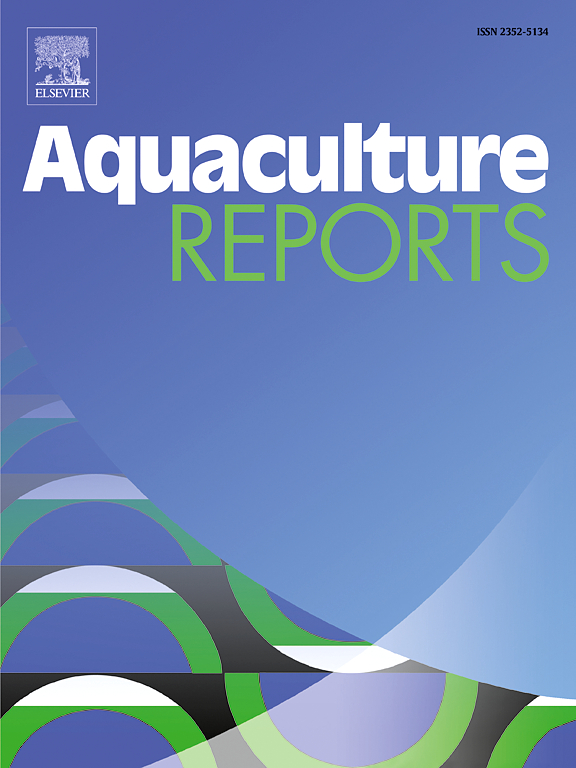不同共食策略对白鲟幼鱼生长、体化学组成、消化酶及gh和igf-1基因表达的影响
IF 3.7
2区 农林科学
Q1 FISHERIES
引用次数: 0
摘要
本研究评估了不同饲养方式对白鲟(Huso huso)幼体的生长性能、体成分、消化酶活性和生长相关基因表达的影响。将 1200 尾幼体(平均体重 0.44 ± 0.01 克)分成四个处理,分别喂养 42 天,或只喂养配方饲料(FD),或混合喂养配方饲料和活饵料(包括摇蚊(CHFD)、蒿(ABFD)或两者(MFD))。结果表明,尽管 FD 组的增重(WG)和蛋白质含量较高,但与其他处理相比,其存活率(SR)最低(P < 0.05)。与 ABFD 组和 MFD 组相比,CHFD 处理的 SR、条件因子和 WG 最高(P < 0.05)。FD组和ABFD组的蛋白质和脂质含量分别明显增加(P < 0.05)。试验结束时,所有处理的总脂肪酸、MUFA、EPA/ARA 和 n-3/n-6 比率也都有所增加(P <0.05)。CHFD 组和 FD 组的 DHA 含量也较高,而各组之间的 PUFA 没有显著差异(P > 0.05)。消化酶的检测结果显示,CHFD 组和 ABFD 组的胰蛋白酶活性较高,这可能表明鱼类适应了配方饲料。基因表达分析表明,FD 组和 ABFD 组的 gh 水平较高,而 CHFD 组的 igf1 水平较高(P < 0.05)。这些研究结果表明,在白鲟幼鱼过渡到配方饲料的过程中,使用摇蚊能显著提高其生长性能和存活率、身体成分、酶活性以及生长相关基因的表达。本文章由计算机程序翻译,如有差异,请以英文原文为准。
Effects of different co-feeding strategies on growth, body chemical composition, digestive enzymes, and expression of gh and igf-1 genes in Beluga sturgeon (Huso huso) larvae
This study evaluates the effect of different feeding regimes on the growth performance, body composition, digestive enzyme activity, and the expression of growth-related genes of Beluga sturgeon (Huso huso) larvae. A total of 1200 larvae (mean weight 0.44 ± 0.01 g) were divided into four treatments and fed either with formulated diet only (FD) or a combination of formulated diet and live food including chironomids (CHFD), Artemia (ABFD), or both (MFD) for 42 days. The results indicated that, despite the higher weight gain (WG) and protein content of the FD group, it had the lowest survival rate (SR) as compared to other treatments (P < 0.05). The CHFD treatment had the highest SR, condition factor, and higher WG than ABFD and MFD groups (P < 0.05). The protein and lipid content increased significantly in FD and ABFD groups, respectively (P < 0.05). The total fatty acids, MUFA, EPA/ARA, and n-3/n-6 ratios were also increased in all treatments at the end of the trial (P < 0.05). DHA levels were also higher in CHFD and FD groups with no significant difference in PUFA between the groups (P > 0.05). The results of digestive enzymes showed higher trypsin activity in CHFD and ABFD groups, which may suggest the adaptation of the fish to the formulated diet. Gene expression analysis revealed that gh levels were higher in FD and ABFD groups while igf1 was up regulated in CHFD group (P < 0.05). These findings suggest that using chironomids during the transition to a formulated diet in Beluga sturgeon larvae can significantly enhanced growth performance and survival, body composition, enzyme activity, and the expression of growth-related genes.
求助全文
通过发布文献求助,成功后即可免费获取论文全文。
去求助
来源期刊

Aquaculture Reports
Agricultural and Biological Sciences-Animal Science and Zoology
CiteScore
5.90
自引率
8.10%
发文量
469
审稿时长
77 days
期刊介绍:
Aquaculture Reports will publish original research papers and reviews documenting outstanding science with a regional context and focus, answering the need for high quality information on novel species, systems and regions in emerging areas of aquaculture research and development, such as integrated multi-trophic aquaculture, urban aquaculture, ornamental, unfed aquaculture, offshore aquaculture and others. Papers having industry research as priority and encompassing product development research or current industry practice are encouraged.
 求助内容:
求助内容: 应助结果提醒方式:
应助结果提醒方式:


